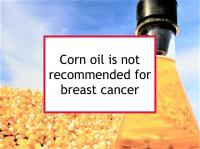Corn oil has a relatively high omega-6 fatty acid content, in the form of linoleic acid (52% to 62% of total fat). Linoleic acid is converted into arachidonic acid in the body. Increasing consumption of corn oil has been shown in animal studies to be associated with higher risks of cancer of the stomach, prostate, pancreas, liver and lung.
Exposure to cooking oil fumes, including corn oil fumes, has been shown to increase the risk of lung cancer. Note that corn is covered in a separate webpage.
Breast cancer-related effects of consuming corn oil
Corn oil consumption has been linked to increased breast cancer risk in human, animal and cell studies.
Human studies
Women with breast cancer have been found to have higher levels of omega-6 fats in their breast tissue than similar women without breast cancer. Several studies have found that lower dietary omega-6/omega-3 ratios are associated with reduced risk of breast cancer. Consuming corn oil would tend to increase the ratio for most women because of its high omega-6 content.
One study reported that women with a specific genotype (ALOX5AP −4900 A > G polymorphism) who consumed a significant amount of linoleic acid in their diets had an increased risk of breast cancer. Another study found increased breast cancer risk among women cooking primarily with high linoleic acid vegetable or corn oil compared to women using olive or canola oil.
Animal studies
Numerous studies have shown that a diet high in corn oil stimulates the formation and growth of breast tumors in laboratory rats. Several experiments also have shown that offspring of rat mothers fed high corn oil diets are more likely to develop mammary tumors than offspring of mothers fed canola oil diets. The explanations given for these findings are related to corn oil's relatively high level of omega-6 fatty acids.
One study reported that a diet rich in corn oil appeared to modify the genomic profile of tamoxifen-treated tumors in a rat model of breast cancer, giving the tumors more aggressive characteristics or resulting in tamoxifen resistance.
Cell studies
Linoleic acid has been reported to promote migration, invasion and angiogenesis of triple negative (ER-/PR-/HER2-) breast cancer cells in several studies.
Insulin is a hormone well known to be involved in the metabolism of carbohydrates. However, insulin is also a growth factor that can stimulate cell proliferation and migration. High circulating insulin levels such as those typical of type 2 diabetes have been shown to increase the risk of breast cancer and its recurrence. Linoleic acid has been shown to amplify the deleterious responses to insulin in both ER+/PR+ and triple negative breast cancer cells.
Additional comments
Note that the breast cancer-linoleic acid connection is not straightforward since omega-6 fats are essential to health. The ratio of omega-6 to omega-3 fats (such as the docosahexaenoic acid (DHA) found in fatty fish) appears to be more important than the absolute amounts of these fatty acids in the diet.
Dietary sources of linoleic acid
Below are common cooking oils with high levels of linoleic acid as a percentage of total fat content:
| Cooking oil | Linoleic acid |
|---|---|
| Safflower oil | 71% to 75% |
| Sunflower oil | 53% to 66% |
| Corn oil | 55% to 59% |
| Soybean oil | 51% to 56% |
Better choices are olive oil (7% to 15% linoleic acid) or canola oil (19% to 26%).
Below are links to recent studies concerning this food and its components. For a more complete list of studies, please click on corn oil.
